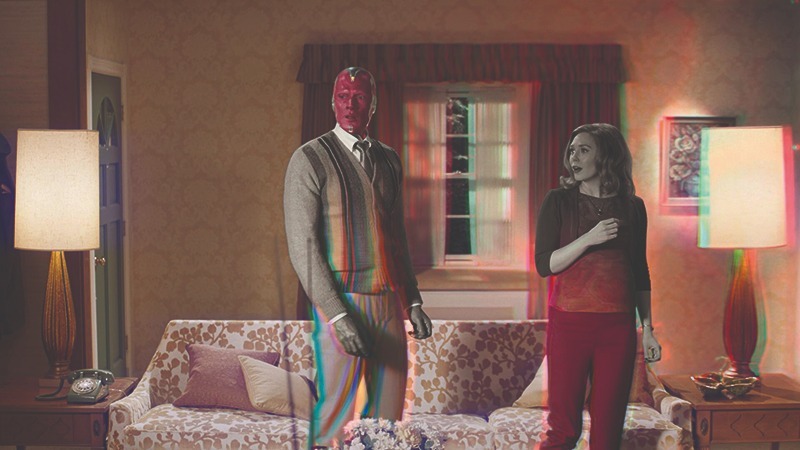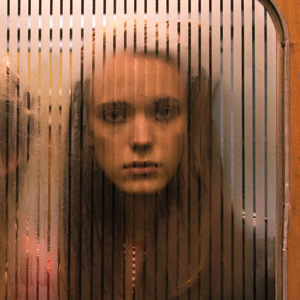
If you don’t look too closely, the opening shots of the new Disney Plus series WandaVision are very familiar. A newlywed couple are driving to their new home in the suburbs. They smile at each other as white picket fences flash past their shiny retro car. Everything is in black and white, soundtracked by a cheesy recap song: “A regular husband and wife / Who left the big city to find a quiet life.” The scene is straight out of a classic American sitcom from the 1950s like I Love Lucy or The Honeymooners. It’s an image that is, for better or worse, part of western pop culture’s DNA.
Upon closer scrutiny, however, this perfect vintage facade crumbles. The husband is anything but “regular”. He is in fact an android wearing a natty suit who can walk through walls. He tries to carry his bride over the threshold in the traditional fashion but drops her on the doormat as he shimmers through the door. She is no less unusual: the next scene shows her dressed in a housewife’s flowery apron, floating plates around using only the power of her mind. The boxy screen ratio and the laughter from the live studio audience might be recognisable, but these characters are like nothing seen in a sitcom before.
That’s because Wanda and Vision are actually characters from a superhero franchise, the Marvel Cinematic Universe (MCU), who have now somehow found themselves on the small screen. As the first episode unfolds, the show deliberately withholds their backstory. They are married and in love, but they can’t answer when other characters ask when their anniversary is or how they met. Vision has an office job filling out forms for a company that has no purpose or product, while Wanda worries at home about whether they “fit in”. Beyond the pratfalls and the gentle jokes, it all starts to seem quite sinister. We last saw them in full colour, sacrificing everything to save the world in 2019’s Avengers: Endgame, currently the highest grossing film of all time. In that timeline, Vision is dead, mourned by a devastated Wanda. So how can they be here, together, in the past? The show glories in this plot disjunction, and is in no hurry to reveal the solution to the mystery.
By far the smartest thing about WandaVision is that it requires no prior knowledge of Marvel’s comic books or films to be enjoyable. The films in the franchise have become increasingly self-referential over the years, culminating with the time-travelling epic of Avengers: Endgame, in which nothing made sense unless you had seen most of the previous 22 MCU instalments. This new show is full of hints about the overarching narrative that diehard fans will enjoy spotting – especially in the fake “adverts” that play in the middle of each episode – but they’re in no way essential for comprehension.
WandaVision is the first original television series to come out of the Marvel stable for Disney Plus. It’s not the first time that characters from the comics have appeared on the small screen – in the mid-2010s there were the now mostly abandoned experiments in licensing heroes out to other producers like ABC Studios and Netflix to create shows like Jessica Jones and Agents of S.H.I.E.L.D. But it is the beginning of a new era for the MCU, which, appropriately enough for these times, no longer spins its stories solely in cinemas.
The company that makes WandaVision has, like some of its characters, been through many different incarnations during the 20th century. Founded in 1939 as Timely Comics, it began publishing writer Stan Lee’s new spin on the superhero trope in the early 1960s under the name Marvel Comics. The likes of Spider-Man, Iron Man, Black Panther and the Hulk garnered legions of fans over the following decades, but by the mid-1990s Marvel was beset by bankruptcy. Cinema was the company’s saviour: films like Men in Black and X-Men, based on characters from Marvel comics, grossed millions and brought an audience that no longer purchased comic books back into contact with the stories. The real turning point for the corporation came in 2008 with the release of Iron Man, which debuted Robert Downey Jr as the titular superhero, a role he would reprise in nine more Marvel films over the next ten or so years. The following year, Disney saw the potential of this multicharacter blockbuster superhero film franchise and acquired Marvel Entertainment for $4 billion dollars.
***
Marvel is not the only American pop culture powerhouse that Disney scooped up once television executive Bob Iger became CEO in 2005. In 2006 it acquired Pixar, bringing films like WALL-E and Finding Nemo under its banner. Then, in 2012, Iger paid another $4 billion for Lucasfilm, the production company founded in the 1970s by George Lucas which made the Star Wars and Indiana Jones films. This spending spree was capped off in 2019 when Disney bought the media conglomerate 21st Century Fox from Rupert Murdoch in a $71 billion deal, which added properties like The Simpsons and Home Alone to its already bulging catalogue.
With this vast array of intellectual property obtained, Disney then set out to move far beyond its traditional animated movie product and disrupt the whole world of television. Netflix, and to a lesser extent Amazon Prime and HBO, had already proved that there was a huge market for series and films that could be streamed at home. Although they also produce original content, the bulk of what is available on their platforms is licensed from other production houses. This selection was a big part of their pitch to customers, and different services competed to offer popular shows like Friends exclusively, as a way of drawing in new subscribers.
***
Disney’s vision was different: they bet on the existing audience for the back catalogue that their aggressive acquisitions had brought them. Rather than trying to be comprehensive or groundbreaking, Disney Plus would offer just their own properties, making it the only place to watch Frozen or Star Wars online. In addition, the streaming service would be home to a dizzying array of future adaptations based on aspects of these already-popular franchises, from Marvel spin-offs like WandaVision to numerous Star Wars-related series including The Mandalorian. By the end of 2020, a year after the initial launch, Disney Plus had 86 million subscribers worldwide. The gamble had paid off, helped by the onset of a global pandemic and an audience stuck at home. Viewers, it turns out, really like what is familiar and nostalgic.
The ramifications for television more broadly of this monopolistic attitude to streaming are yet to be fully felt. The fear is that Disney’s deep dive into endlessly adapting existing stories will help to further bind the entertainment industry into a culture of remaking and rebooting. The pool of studios that have the money to take chances on original stories seems to keep shrinking.
But WandaVision, already a critical success, does seem to offer some hope that we aren’t approaching some imminent corporate pop culture singularity. Appropriately enough, it is a show about the evolution of television itself, lovingly crafted in homage to the hits of decades past in all aspects of the production. From the painstaking use of wires rather than CGI to make Wanda’s magic look just like Samantha’s from Bewitched in the early episodes, to the way the camera angles and shooting style change as the show moves through the years, it’s a series that is very conscious of its medium. Taking these two minor characters from a famous franchise – their relationship receives about ten minutes of screen time over the many hours of Marvel’s cinematic output to date – the writers and actors have found a niche in which to create something truly weird. The way we watch television is evolving: perhaps it’s time our superheroes did too.
This article is from the New Humanist spring 2021 edition. Subscribe today.

